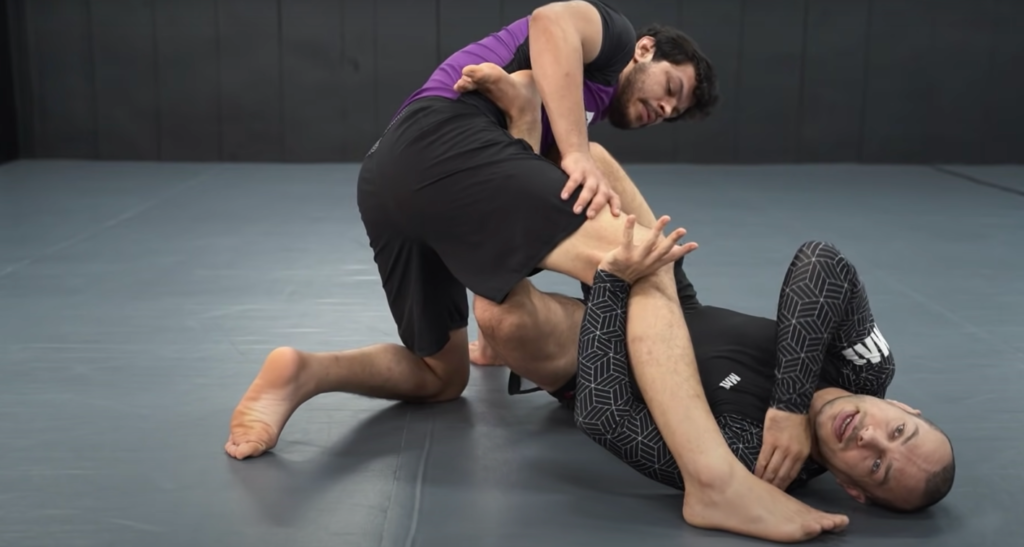
The K Guard is a popular and effective position in Brazilian Jiu-Jitsu that has been utilized by some of the best modern-day competitors in the sport. Although a relatively new invention, the K Guard has already evolved and now plays a significant role in modern-day BJJ. This comprehensive guide aims to provide you with a complete understanding of the K Guard in BJJ, covering everything from its history and advantages to its techniques and how to deal with it.
What Is The K Guard In BJJ?
The K Guard is a BJJ guard position where the bottom player has the shin of one leg in between their hips and the hips of an opponent. That leg is placed with the knee on the mats, and the sole of the foot pointing towards the ceiling. This leg has the goal of creating and keeping distance, and healing you stay attached to your opponent.
The other leg acts as a support to the bottom leg with the knee touching the first leg’s ankle. The shin of the second leg goes on the opponent’s chest.
The grips are the key part of the position, clasped together in a gable grip behind the opponent’s leg.
This position creates a “K” shape, hence the name K Guard.
The K Guard is an excellent position to control your opponent’s movement and prevent them from escaping or advancing their position. It also provides a great platform to execute sweeps and take your opponent to the ground. You can use the K Guard to transition into other positions like the X Guard or the butterfly guard to create different sweeping options.
The K Guard is also great for multiple submission opportunities like the triangle choke, the Omoplata, the armbar, and many different leg locks.
Who Invented the Jiu-Jitsu K Guard?
The story of the K Guard is an interesting one. People know more about the person who made the position famous, which is Lachlan Giles as opposed to the people behind it. Interestingly enough, there are two people behind the initial K guard, and they both developed parts of it independently of one another. Those are Neil Melanson and Aaron Millam.
It took Lachaln though, to merge what they both developed,d and introduce a few his own thoughts into the mix to create the perfect position to play guard from, whether you’re a beginner or an expert, with or without a Gi.
Advantages Of Playing K Guard
Control of Your Opponent
The combination of the Gable grips and the unique frame created with the legs are what give this guard its power. It is very easy to get to and offers extreme amounts of control. It also prevents lots of passes while requiring next to no energy to maintain. The guard is easy to learn and will benefit lower belts who are trying to deal with upper belts, and even some black belts.
Versatile Attacking Position
The K Guard offers a wide range of attacking options. Once you have your opponent trapped in it, you can use a variety of techniques to submit them. For example, you can set up arm locks, chokes, and leglocks, or decide to go on top by using sweeps.
Easy Retention
The K Guard is also an effective defensive position. If your opponent is on top of you and trying to pass your guard, you can use the K Guard to prevent them from doing so. The position allows you to greatly restrict their movement, making it difficult for them to disengage from the legs in order to achieve a pass or even attempt one.
Branching Out
It is easy to link the K guard with other guards, ranging from the fundamental positions like the closed guard to modern-day guards like the 50/50 and lapel guards. It is also a very useful position to open up back attacks.
Dynamic K Guard Entry Options
To get into the K Guard, you need to know the proper entry techniques. There are various ways to enter the guard, mostly from other guards as means of retaining an offensive and effective open guard when opponents beat some initial guard positions like the half guard, butterfly guard, closed guard, De la Riva, etc.
Closed Guard
One of the most popular ways to enter the K Guard is through the closed guard. Any time the top person tries to execute a standing pass, all you need to do is drop one knee to the mats and establish the Gable grip. As the opponent is forced to come back to the mats, you can use the second leg to block them from smashing you and start attacking.
Single Leg X Guard
Another effective way to enter the K Guard is through the Single Leg X Guard. This technique involves trapping your opponent’s free leg with your arms, prior to releasing the X guard leg to enter into the K guard on the opposite side.
De La Riva Guard To K Guard
Finally, you can also enter the K Guard from the De La Riva guard position. This technique involves releasing the DE La Riva hook and using that leg to establish the first leg position of the K guard. Adding the grip makes the position stable, and introducing the second leg means you can start attacking.
K Guard Attacks
The submission options from the K guard are versatile, offering all types of submissions. From a points-scoring standpoint, sweeps are the next best thing, with back takes also available, after some repositioning and work.
K Guard Sweeps
Shoulder Crunch Sweep
If you’re playing the K guard against a kneeling opponent, yo can use the same grip on the opponent’s shoulder rather than the leg. The first leg then goes on the opponent’s same side knee, pushing as you turn towards the shoulder you’re crunching for a very easy sweep.
Pendulum Sweep
The Pendulum sweep is a powerful sweep that can catch your opponent off guard. To execute the Pendulum sweep, you need to let go of the Gable grip with the top arm and grab the opponent’s collar, blocking their far side arm.
From there, you need to swing your legs to the side, creating a pendulum-like motion. As your legs swing back towards your opponent, you can use your feet to kick their leg out from under them, causing them to fall onto their back.
K Guard Armbar
To execute an armbar from the K Guard position, you need to open up the second leg wide so that to have space to trap the opponent’s far side arm in between your legs. Then you simply get that second leg back, placing it across the head for a very tight armlock finish.
K Guard Triangle
The triangle and armbar work closely together from the K as well as from the closed guard. From the same setup as before, keeping the second leg wide, if you can’t sneak the opponent’s arm in for an armbar, you can simply get the second leg over their shoulder, and do a triangle choke instead. The other leg is already in place via the K-guard structure.
K Guard Leg Locks
To execute a leg lock from the K Guard position, you need to first establish an Ashi Garami position. There is a multitude of those available straight from the K guard, depending on whether an opponent is standing or kneeling.
The easiest way to get to leg locks is to swing the second leg over the leg you’re controlling with the first leg and the Gable grip. This gets you into the 50/50 which offers an array of different leg locking options, most of the heel hook variety.
Kneebars are also really easy to get from the K guard, particularly against standing opponents. all you need to do is go for the same swinging motion with the second leg over the leg you’re controlling.
K Guard Back Takes
The back is relatively easily available from the K guard, particularly when you connect it with leg locks. If the opponent manages to get the leg you’re controlling with the guard on the opposite side ofyour torso, they’ve given you easy access to their back. Just secure a rear body lock with your arms around their waist to make sure you have enough time and control to get the hooks in.
How To Deal With The K Guard
Getting out of the K guard is not easy, and passing it can be even harder, particularly with the Gi. There are ways to deal with it but you have to remember that you have to neutralize the structure of the guard first, otherwise you’re just playing in the traps set by the bottom person.
BJJ K Guard Counters
There is a slick little counter to the K guard, but it is based on timing. If you can slide the knee of your free leg on the opponent’s first leg, you can kill the guard, but only if you can do this before the Gable grip is set.
If you are late, you’ll only fall prey to sweeps and most likely, leg locks by attempting this against a fully locked-in K guard.
BJJ K Guard Passing
There is a pass that works against the guard, but it is a bit risky. To open up space for it, you have to try and get the opponent’s second leg across their body, which puts them in the position for leg locks and back takes.
However, if you time it right, you can use your free leg, and place the Achilles tendon behind the knee of the opponent’s first leg. A Grip on the rim of the pants will Open up a leg drag-like position for you that can lead to a pass or a direct back take.
Building A K Guard System For BJJ
The K guard is so easy to introduce into your game, that you can actually build an entire system around it, and have an easy solution when it comes to your bottom game for both Gi and No-Gi Jiu-Jitsu.
1: Understand The Basics Of The K Guard
Before you can build a full K Guard system, you need to have a solid understanding of the basics of the position. Focus on figuring out the angles of the legs, and how to keep the palms together in the Gable grip. From this position, you can control your opponent’s posture, set up sweeps, and attack with submissions.
2: Develop Your Sweeps
The first step in building a full K Guard system is to develop your sweeps. Sweeps are a crucial part of the K Guard game and can be used to off-balance your opponent and take them down to the ground. Practice sweeps like the pendulum sweep and shoulder crunch sweep, to build a double-trouble threat for your K Guard game.
3: Incorporate Submissions
Once you have a solid base of sweeps, it’s time to incorporate submissions into your K Guard game. The triangle choke, armbar, and leg locks are all effective submissions from the K Guard position. Chaing them together from the same position is rarely possible in JIu-Jitsu which is why this guard variation has so much value and potential.
4: Learn to Transition to Other Positions
While the K Guard is a powerful position in its own right, it’s important to learn how to transition to other positions as well. Practice transitioning to the butterfly guard, X Guard, or single-leg X Guard to keep your opponent guessing and create more opportunities for attacks.
5: Drill Your System
The key to building a full K Guard system is to drill your techniques regularly. Spend time every training session practicing your sweeps, submissions, and transitions to build muscle memory and refine your technique. Drill with a partner or on your own with a grappling dummy to get the most out of your training.
6: Experiment with Variations
As you become more comfortable with the K Guard position, don’t be afraid to experiment with variations. Try variations like the reverse K Guard or the K Spider Guard to find new ways to control your opponent and set up attacks.
7: Train with Higher-Level Partners
To truly build a full K Guard system, you need to train with higher-level partners during the rolling. Seek out training partners who have a deep understanding of the position and can offer you feedback and advice on how to improve.
Conclusion
The K Guard is a highly effective position in BJJ that offers a wide range of offensive and defensive options. By understanding its basics, advantages, and techniques, you can add it to your arsenal of BJJ skills and become a more well-rounded competitor. With the knowledge and techniques provided in this guide, you’ll be well on your way to mastering the K Guard and improving your overall BJJ skills.


![Darce Choke Encyclopedia – Origins, Mechanics and Variations [2025] BJJ, choke, Brabo, BJJ Darce Choke, D'arce Choke, Darce BJJ Choke](https://bjj-world.com/wp-content/uploads/2017/11/JungPoirierLeeYahoo-218x150.jpg)


















![Slicin’ Calves Mikey Musumeci DVD Review [2025] Slicin' Calves Mikey Musumeci DVD Review](https://bjj-world.com/wp-content/uploads/2025/04/slicin-calves-mikey-musumeci-dvd-review-218x150.png)
![Jiu-Jitsu For Old Guys Guard Retention Bernardo Faria DVD Review [2025] Jiu-Jitsu For Old Guys Guard Retention Bernardo Faria DVD Review](https://bjj-world.com/wp-content/uploads/2025/03/old-guys-guard-retention-bernardo-faria-dvd-review-218x150.png)
![X-Guard Trickery Kyle Sleeman DVD Review [2025] X-Guard Trickery Kyle Sleeman DVD Review](https://bjj-world.com/wp-content/uploads/2025/03/x-guard-trickery-kyle-sleeman-dvd-review-218x150.png)
![Countering with Crab Ride Anthony Budion DVD Review [2025] Countering with Crab Ride Anthony Budion DVD Review](https://bjj-world.com/wp-content/uploads/2025/03/countering-with-crab-ride-anthony-budion-dvd-review-218x150.png)
![Breaking Their Guard Mikey Musumeci DVD Review [2025] Breaking Their Guard Mikey Musumeci DVD Review](https://bjj-world.com/wp-content/uploads/2025/02/breaking-their-guard-mikey-musumeci-dvd-review-324x235.png)
![Basic Closed Guard Jasmine Rocha DVD Review [2024] Basic Closed Guard Jasmine Rocha DVD Review](https://bjj-world.com/wp-content/uploads/2024/11/basic-closed-guard-jasmine-rocha-dvd-review-100x70.png)
![Shotgun Aoki Locks Mateusz Szczecinski DVD Review [2025] Shotgun Aoki Locks Mateusz Szczecinski DVD Review](https://bjj-world.com/wp-content/uploads/2025/03/shotgun-aoki-locks-mateusz-szczecinski-dvd-review-100x70.png)
![Giancarlo Bodoni DVD Bundle Essential Connections Full Review [2024] Giancarlo Bodoni DVD Bundle Essential Connections Full Review](https://bjj-world.com/wp-content/uploads/2024/09/giancarlo-bodoni-dvd-bundle-essential-connections-100x70.png)

![Advantage Over Time Outside Passing Jozef Chen DVD Review [2025] Advantage Over Time Outside Passing Jozef Chen DVD Review](https://bjj-world.com/wp-content/uploads/2025/03/outside-passing-jozef-chen-dvd-review-100x70.png)
![The Empty Half Guard Michael Currier DVD Review [2025] The Empty Half Guard Michael Currier DVD Review](https://bjj-world.com/wp-content/uploads/2025/03/empty-half-guard-michael-currier-dvd-review-100x70.png)



![Slip N Slide Into Victory Julián Espinosa DVD Review [2025] Slip N Slide Into Victory Julián Espinosa DVD Review](https://bjj-world.com/wp-content/uploads/2025/01/slip-n-slide-into-victory-julian-espinosa-dvd-review-100x70.png)
![BJJ Foundations Mikey Musumeci DVD Bundle Review [2024] BJJ Foundations Mikey Musumeci DVD Bundle Review](https://bjj-world.com/wp-content/uploads/2024/09/bjj-foundations-mikey-musumeci-dvd-bundle-review-100x70.png)
![No-Gi Grapplers Guide To Front Headlock Joel Bane DVD Review [2025] No-Gi Grapplers Guide To Front Headlock Joel Bane DVD Review](https://bjj-world.com/wp-content/uploads/2025/03/no-gi-front-headlock-joel-bane-dvd-review-100x70.png)
![Front Head Lock Kaynan Duarte DVD Review [2025] Front Head Lock Kaynan Duarte DVD Review](https://bjj-world.com/wp-content/uploads/2025/02/front-head-lock-kaynan-duarte-dvd-review-100x70.png)
![Higher Tripod Passing Craig Jones DVD Review [2025] Higher Tripod Passing Craig Jones DVD Review](https://bjj-world.com/wp-content/uploads/2025/02/higher-tripod-passing-craig-jones-dvd-review-100x70.png)
![Two Sides One Game Sweep and Pass Marcos Tinoco DVD Review [2024] Two Sides One Game Sweep and Pass Marcos Tinoco DVD Review](https://bjj-world.com/wp-content/uploads/2024/11/sweep-and-pass-marcos-tinoco-dvd-review-100x70.png)


![Darces From Everywhere Kade and Tye Ruotolo DVD Review [2024] Darces From Everywhere Kade and Tye Ruotolo DVD Review](https://bjj-world.com/wp-content/uploads/2024/10/darces-from-everywhere-kade-and-tye-ruotolo-dvd-cover-100x70.png)

![Shin to Shin Eoghan O’Flanagan DVD Review [2025] Shin to Shin Eoghan O'Flanagan DVD Review](https://bjj-world.com/wp-content/uploads/2024/12/shin-to-shin-eoghan-oflanagan-dvd-review-100x70.png)
![Slay The Wrestle Up Guard Nick Rodriguez DVD Review [2024] Slay The Wrestle Up Guard Nick Rodriguez DVD Review](https://bjj-world.com/wp-content/uploads/2024/12/slay-the-wrestle-up-guard-nick-rodriguez-dvd-review-100x70.png)
![Creating Back Exposure Luke Griffith DVD Review [2025] Creating Back Exposure Luke Griffith DVD Review](https://bjj-world.com/wp-content/uploads/2025/01/creating-back-exposure-luke-griffith-dvd-review-100x70.png)
![X-Guard Trickery Kyle Sleeman DVD Review [2025] X-Guard Trickery Kyle Sleeman DVD Review](https://bjj-world.com/wp-content/uploads/2025/03/x-guard-trickery-kyle-sleeman-dvd-review-100x70.png)

![Knee Lever John Wayne Sweep Adam Wardzinski DVD Review [2024] Knee Lever John Wayne Sweep Adam Wardzinski DVD Review](https://bjj-world.com/wp-content/uploads/2024/12/john-wayne-sweep-adam-wardzinski-dvd-review-100x70.png)
![Reverse Armlock Magid Hage DVD Review [2024] Reverse Armlock Magid Hage DVD Review](https://bjj-world.com/wp-content/uploads/2024/12/reverse-armlock-magid-hage-dvd-review-100x70.png)
![Modern Split Squat Passing Jason Rau DVD Review [2024] Modern Split Squat Passing Jason Rau DVD Review](https://bjj-world.com/wp-content/uploads/2024/11/modern-split-squat-passing-jason-rau-dvd-review-100x70.png)
![Tiny Woman Guide To The Guard Ann Kneib DVD Review [2024] Tiny Woman Guide To The Guard Ann Kneib DVD Review](https://bjj-world.com/wp-content/uploads/2024/11/tiny-woman-guide-to-the-guard-ann-kneib-dvd-review-100x70.png)